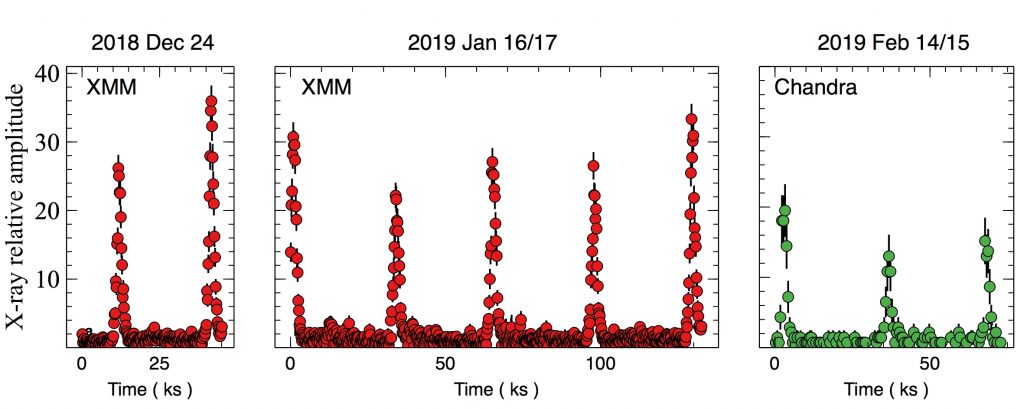
During an ESA’s XMM-Newton observation on 2018 Christmas Eve, an international team led by Giovanni Miniutti, of the Centro de Astrobiología (CAB, CSIC-INTA) in Madrid, discovered some mysterious flashes from the active black hole at the core of the galaxy GSN 069, about 250 million light years away. X-ray emission from the center of that galaxy was seen to suddenly increase its brightness by up to a factor 100, then dimmed back to its normal levels within one hour and lit up again nine hours later. Giant black holes regularly flicker like a candle but the rapid, repeating changes seen in GSN 069 had never been observed before from supermassive black hole at the core of galaxies.
Further observations, performed with XMM-Newton as well as NASA’s Chandra X-ray observatory in the following couple of months, confirmed that the distant black hole was still keeping the tempo, emitting nearly periodic bursts of X-rays every nine hours. The researchers are calling the new phenomenon ‘quasi-periodic eruptions’, or QPEs.
The black hole in GSN 069 is most likely a “low-mass” one with respect to the typical population. The bigger and more massive the black hole, the slower the fluctuations it can display, so a typical supermassive black hole would erupt not every nine hours, but every few months or years. This would make detection unlikely as observations rarely span such long periods of time, and would explain why QPEs have not been detected before. In fact, quasi-periodic eruptions like those found in GSN 069 could provide a template to interpret some of the most enigmatic variation observed from supermassive black holes, whose brightness seems to vary too fast to be easily explained by current theoretical models.
Based on results published on-line in Nature on 2019 September 11 by G. Miniutti et al. [link]
Further reading:
Read the ‘Behind the paper’ story [https://astronomycommunity.nature.com/users/300795-giovanni-miniutti/posts/53402-newly-discovered-x-ray-quasi-periodic-eruptions-qpes-from-a-galactic-nucleus-may-shed-light-on-bh-accretion]
Read Nature “News and Views” on this discovery [https://www.nature.com/articles/d41586-019-02652-y]
ESA/XMM-Newton press release [http://www.esa.int/Our_Activities/Space_Science/Unexpected_periodic_flares_may_shed_light_on_black_hole_accretion]
NASA/Chandra press release [https://chandra.harvard.edu/photo/2019/gsn069/]
